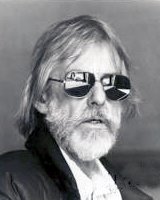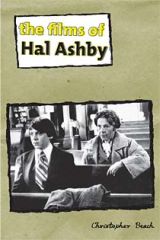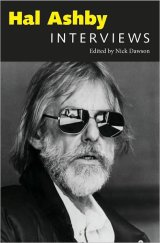| Hal ASHBY | William Hal Ashby |
 * 02.09.1929, Ogden, Utah, USA † 27.12.1988, Malibu,
California, USA * 02.09.1929, Ogden, Utah, USA † 27.12.1988, Malibu,
California, USARegisseur, Cutter * verläßt die Highschool und schlägt sich zunächst mit Gelegenheitsjobs durch * geht 1950 nach Los Angeles und bekommt schließlich Arbeit bei verschiedenen Filmstudios (Universal, Republic) * arbeitet als Cutterassistent (The Children's Hour, 1961) und ab 1964 als full editor [Cutter] * 1965-68 schneidet ausschließlich Filme von Norman Jewison und bekommt 1968 für In the Heat of the Night einen Oscar für den besten Schnitt * 1969 Debüt als Filmregisseur (The Landlord - von Norman Jewison produziert) * im Laufe der folgenden Dekade entwickelt sich mit einer Reihe von künstlerisch und oft auch kommerziell erfolgreichen Werken zu einem der führenden Regisseure der 70er Jahre und erlebt 1978 mit dem Antikriegsdrama Coming Home den Höhepunkt seiner Laufbahn als Regisseur * in den 80ern kann an seine früheren Erfolge nicht mehr anknüpfen - 1981 dokumentiert eine Tournee der Rolling Stones (Let's Spend the Night Together) * stirbt mit 59 Jahren an Krebs |
| FILMS |
The Landlord (Der Hausbesitzer, 1969-USA; R: Hal Ashby, B: Bill Gunn, K: Gordon Willis, M: Al Kooper, D: Beau Bridges, Lee Grant, Diana Sands & Pearl Bailey) 114m-Gesellschaftssatire (Roman von Kristin Hunter) (7005) Harold and Maude (Harold und Maude, 1970/71-USA; R: Hal Ashby, B: Colin Higgins, K: John A. Alonzo, D: Ruth Gordon, Bud Cort) 91m-Schwarze Komödie (7112) The Last Detail (Das letzte Kommando, 1972/73-USA; R: Hal Ashby, B: Robert Towne, K: Michael Chapman, M: Johnny Mandel, D: Jack Nicholson, Otis Young, Randy Quaid) 105m-Tragikomödie (Roman von Darryl Ponicsan) (7312) Shampoo (1974-USA) (7502) Bound for Glory (Dieses Land ist mein Land, 1975/76-USA; R: Hal Ashby, B: Robert Getchell, K: Haskell Wexler, MA: Leonard Rosenman, D: David Carradine, Ronny Cox, Melinda Dillon, Gail Strickland & Randy Quaid) 147m-Musikerbiografie (Autobiografie/Buch von Woody Guthrie) (7612) Coming Home (1977-USA) (7802) Second-Hand Hearts (Herzen aus zweiter Hand, 1978-USA; R: Hal Ashby, B: Charles Eastman, K: Haskell Wexler, M: Willis Alan Ramsey, D: Robert Blake, Barbara Harris) 102m-Komödie (8105) Being There (1979-USA) (Roman von Jerzy Kosinski) (7912) Lookin' to Get Out (Der Zocker, 1980-USA; R: Hal Ashby, B: Al Schwartz, Jon Voight, K: Haskell Wexler, M: Johnny Mandel, D: Jon Voight, Ann-Margret, Burt Young) 105m-Komödie (8210) The Slugger's Wife (Die Frau des Profis, 1984-USA; R: Hal Ashby, B: Neil Simon, K: Caleb Deschanel, M: Patrick Williams, D: Michael O'Keefe, Rebecca DeMornay) 105m-Komödie (8503) 8 Million Ways to Die (8 Millionen Wege zu sterben, 1985-USA; R: Hal Ashby, B: Oliver Stone, David Lee Henry, K: Stephen H. Burum, M: James Newton Howard, D: Jeff Bridges, Rosanna Arquette) 115m-Thriller (Buch/Roman von Lawrence Block) (8604) |
| BOOKS |
Hal Ashby directed eleven feature films over the course of his career and was an important figure in the Hollywood Renaissance of the late 1960s and 1970s. Though he was a member of the same generation of filmmakers as Martin Scorsese, Francis Ford Coppola, and Robert Altman, Ashby has received comparatively little critical or scholarly validation for his work. Author Christopher Beach argues that despite his lower profile, Ashby was an exceptionally versatile and unusually creative director. Beach focuses primarily on Ashby’s first seven films - The Landlord, Harold and Maude, The Last Detail, Shampoo, Bound for Glory, Coming Home, and Being There - to analyze Ashby’s contributions to filmmaking culture in the 1970s. The first two chapters of this volume provide an overview of Ashby’s filmmaking career, as Beach makes the case for Ashby’s status as an auteur and provides a biographical survey of Ashby’s most productive and successful decade, the 1970s. In the following chapters, Beach analyzes groups of films to uncover important thematic concerns in Ashby’s work, including the treatment of a young male protagonist in The Landlord and Harold and Maude, the representation of the U.S. military in The Last Detail and Coming Home, and the role of television and mass media in Shampoo and Being There. Beach also examines the crucial role of the musical score in Ashby’s films, as well as the rapid decline of the director’s career after Being There. The Films of Hal Ashby is based on Beach’s extensive use of unpublished archival materials, as well as a number of interviews with actors, directors, producers, cinematographers, and others involved in the making of Ashby’s films. This volume will interest film and television scholars, as well as readers interested in filmmakers of the 1970s. > Pages: 224, Illustrations: 8 |
Hal Ashby set the standard for subsequent independent filmmakers by crafting unique, thoughtful, and challenging films that continue to influence new generations of directors. Initially finding success as an editor, Ashby won an Academy Award for editing In the Heat of the Night (1967), and he translated his skills as an editor into a career as one of the quintessential directors of 1970s. Perhaps best remembered for the enduring cult classic Harold and Maude (1971), Ashby quickly became known for melding quirky comedy and intense drama with performances from A-list actors such as Jack Nicholson in The Last Detail (1973), Warren Beatty and Goldie Hawn in Shampoo (1975), Jon Voight and Jane Fonda in Coming Home (1978), and Peter Sellers and Shirley MacLaine in Being There (1979). Ashby’s personal life was difficult. He endured his parents’ divorce, his father’s suicide, and his own failed marriage all before the age of nineteen, and his notorious drug abuse contributed to the decline of his career near the end of his life. Ashby always operated outside Hollywood’s conventions, and though his output was tragically limited, the quality of his films continues to inspire modern directors as varied and talented as Judd Apatow and Wes Anderson, both of whom acknowledge Ashby as a primary influence. In Being Hal Ashby: Life of a Hollywood Rebel, the first full-length biography of the maverick filmmaker, author Nick Dawson masterfully tells the turbulent story of Ashby’s life and career. > 440 pages, hardcover |
Hal Ashby (1929-1988) is considered to be the lost genius of the New Hollywood generation. While his name does not bear the familiarity of, say, Robert Altman or Martin Scorsese, his diverse films are among the best known and most beloved of the era. From the cult classic Harold and Maude (1971) to the iconic political satire Being There (1979), from the subversive sex comedy Shampoo (1975) to the anti-Vietnam romance Coming Home (1979), Ashby rejected mainstream conventions while his films attracted both popular and critical praise. A true actors' director, Ashby drew A-list stars and elicited powerful performances from Jack Nicholson in The Last Detail (1973), Warren Beatty and Julie Christie in Shampoo, Jon Voight and Jane Fonda in Coming Home, and Peter Sellers in Being There. Hal Ashby: Interviews for the first time brings together the best interviews conducted over the course of Ashby's career. Ashby discusses his filmmaking philosophy, memories of working his way up the Hollywood ladder in the 1950s, and his troubled productions in the 1980s. > Paperback , 128pp |
| home © midas 01/2010 |
 Christopher Beach: The Films of Hal Ashby. Detroit: Wayne State University Press, 2009
Christopher Beach: The Films of Hal Ashby. Detroit: Wayne State University Press, 2009 Nick Dawson: Being Hal Ashby: Life of a Hollywood Rebel. Lexington: University Press of Kentucky, 2009
Nick Dawson: Being Hal Ashby: Life of a Hollywood Rebel. Lexington: University Press of Kentucky, 2009 Nick Dawson [Hg.]: Hal Ashby: Interviews. Jackson: University Press of Mississippi, 2010
Nick Dawson [Hg.]: Hal Ashby: Interviews. Jackson: University Press of Mississippi, 2010